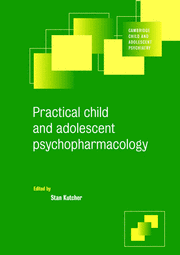Book contents
- Frontmatter
- Contents
- List of contributors
- Preface and acknowledgements
- 1 Child and adolescent psychopharmacology at the turn of the millennium
- 2 Developmental psychopharmacology
- 3 Clinical aspects of child and adolescent psychopharmacology
- 4 Depression
- 5 Bipolar mood disorders: diagnosis, etiology, and treatment
- 6 Schizophrenia and related psychoses
- 7 Obsessive–compulsive disorder
- 8 Anxiety disorders
- 9 Attention-deficit/hyperactivity disorder
- 10 Pervasive development disorder
- 11 Aggressive behavior
- 12 Adolescent substance use disorder
- 13 Tic disorders and Tourette's syndrome
- 14 Eating disorders and related disturbances
- 15 Medical psychiatric conditions
- Index
Preface and acknowledgements
Published online by Cambridge University Press: 31 August 2009
- Frontmatter
- Contents
- List of contributors
- Preface and acknowledgements
- 1 Child and adolescent psychopharmacology at the turn of the millennium
- 2 Developmental psychopharmacology
- 3 Clinical aspects of child and adolescent psychopharmacology
- 4 Depression
- 5 Bipolar mood disorders: diagnosis, etiology, and treatment
- 6 Schizophrenia and related psychoses
- 7 Obsessive–compulsive disorder
- 8 Anxiety disorders
- 9 Attention-deficit/hyperactivity disorder
- 10 Pervasive development disorder
- 11 Aggressive behavior
- 12 Adolescent substance use disorder
- 13 Tic disorders and Tourette's syndrome
- 14 Eating disorders and related disturbances
- 15 Medical psychiatric conditions
- Index
Summary
The field of child and adolescent psychopharmacology is rapidly growing and every clinician, physician, and other health provider alike must be informed of new directions and applications in the use of medications as they pertain to the treatment of psychiatric disorders in children and adolescents. To date, considerable research has been conducted which can properly direct the use of a variety of psychotropic compounds in a number of child and adolescent psychiatric disorders. In particular, well-established and effective pharmacologic treatments are available for attention-deficit hyperactivity disorder, obsessive-compulsive disorder, and Tourette's syndrome. Less well-established but nonetheless frequently applied pharmacotherapies are used to treat a variety of psychiatric illness (such as major depression, schizophrenia, bipolar mania) or specific symptoms which may occur independently or as a component of a particular psychiatric diagnosis – such as aggression in pervasive developmental disorder.
Evidence and experience to date clearly indicates that psychopharmacologic treatments for children and teenagers cannot be extrapolated from studies conducted in adult patients. Young people have a different central nervous system development, exhibit different cognitive, behavioral, and affective “norms” and are exposed to different environmental influences. All of these factors can influence the response to pharmacologic treatments – efficacy as well as tolerability. Thus, the study and practice of pharmacologic treatments of child and adolescent psychiatric disorders must become a special and significant area in its own right.
- Type
- Chapter
- Information
- Practical Child and Adolescent Psychopharmacology , pp. xiii - xivPublisher: Cambridge University PressPrint publication year: 2002



